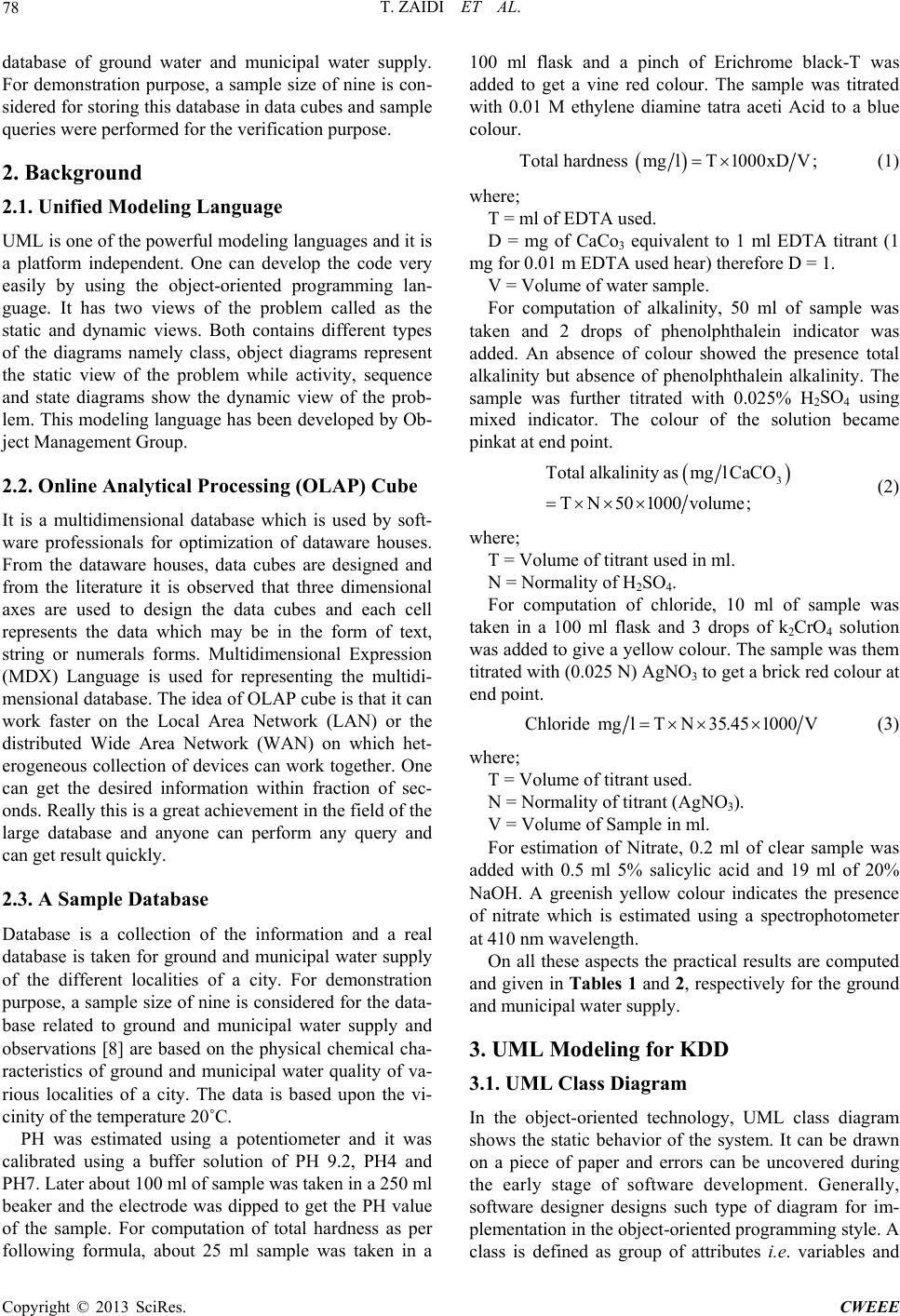
T. ZAIDI ET AL.
78
database of ground water and municipal water supply.
For demonstration purpose, a sample size of nine is con-
sidered for storing this database in data cubes and sample
queries were performed for the verification purpose.
2. Background
2.1. Unified Modeling Language
UML is one of the powerful modeling languages and it is
a platform independent. One can develop the code very
easily by using the object-oriented programming lan-
guage. It has two views of the problem called as the
static and dynamic views. Both contains different types
of the diagrams namely class, object diagrams represent
the static view of the problem while activity, sequence
and state diagrams show the dynamic view of the prob-
lem. This modeling language has been developed by Ob-
ject Management Group.
2.2. Online Analytical Processing (OLAP) Cube
It is a multidimensional database which is used by soft-
ware professionals for optimization of dataware houses.
From the dataware houses, data cubes are designed and
from the literature it is observed that three dimensional
axes are used to design the data cubes and each cell
represents the data which may be in the form of text,
string or numerals forms. Multidimensional Expression
(MDX) Language is used for representing the multidi-
mensional database. The idea of OLAP cube is that it can
work faster on the Local Area Network (LAN) or the
distributed Wide Area Network (WAN) on which het-
erogeneous collection of devices can work together. One
can get the desired information within fraction of sec-
onds. Really this is a great achievement in the field of the
large database and anyone can perform any query and
can get result quickly.
2.3. A Sample Database
Database is a collection of the information and a real
database is taken for ground and municipal water supply
of the different localities of a city. For demonstration
purpose, a sample size of nine is considered for the data-
base related to ground and municipal water supply and
observations [8] are based on the physical chemical cha-
racteristics of ground and municipal water quality of va-
rious localities of a city. The data is based upon the vi-
cinity of the temperature 20˚C.
PH was estimated using a potentiometer and it was
calibrated using a buffer solution of PH 9.2, PH4 and
PH7. Later about 100 ml of sample was taken in a 250 ml
beaker and the electrode was dipped to get the PH value
of the sample. For computation of total hardness as per
following formula, about 25 ml sample was taken in a
100 ml flask and a pinch of Erichrome black-T was
added to get a vine red colour. The sample was titrated
with 0.01 M ethylene diamine tatra aceti Acid to a blue
colour.
Total hardness mglT1000xDV; (1)
where;
T = ml of EDTA used.
D = mg of CaCo3 equivalent to 1 ml EDTA titrant (1
mg for 0.01 m EDTA used hear) therefore D = 1.
V = Volume of water sample.
For computation of alkalinity, 50 ml of sample was
taken and 2 drops of phenolphthalein indicator was
added. An absence of colour showed the presence total
alkalinity but absence of phenolphthalein alkalinity. The
sample was further titrated with 0.025% H2SO4 using
mixed indicator. The colour of the solution became
pinkat at end poin t.
3
Total al k alinity asmglCaCO
TN501000 volume; (2)
where;
T = Volume of titrant used in ml.
N = Normality of H2SO4.
For computation of chloride, 10 ml of sample was
taken in a 100 ml flask and 3 drops of k2CrO4 solution
was added to give a yellow colou r. The sample was them
titrated with (0.025 N) AgNO3 to get a brick red colour at
end point.
Chloride mglTN35.451000V
(3)
where;
T = Volume of titrant used.
N = Normality of titrant (AgNO3).
V = Volume of Sample in ml.
For estimation of Nitrate, 0.2 ml of clear sample was
added with 0.5 ml 5% salicylic acid and 19 ml of 20%
NaOH. A greenish yellow colour indicates the presence
of nitrate which is estimated using a spectrophotometer
at 410 nm wavelength.
On all these aspects the practical results are computed
and given in Tables 1 and 2, respectively for the ground
and municipal water supply.
3. UML Modeling for KDD
3.1. UML Class Diagram
In the object-oriented technology, UML class diagram
shows the static behavior of the system. It can be drawn
on a piece of paper and errors can be uncovered during
the early stage of software development. Generally,
software designer designs such type of diagram for im-
plementation in the object-oriented programming style. A
class is defined as group of attributes i.e. variables and
Copyright © 2013 SciRes. CWEEE